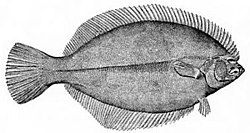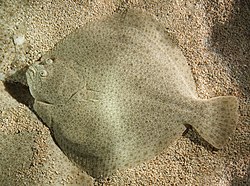| Soles Temporal range: | |
|---|---|
 | |
| Sand sole, Pegusa lascaris | |
| Scientific classification | |
| Kingdom: | Animalia |
| Phylum: | Chordata |
| Class: | Actinopterygii |
| Order: | Carangiformes |
| Suborder: | Pleuronectoidei |
| Family: | Soleidae Bonaparte, 1832 |
| Genera [1] | |
See text | |
The true soles are a family, Soleidae, of flatfishes. It includes saltwater and brackish water species in the East Atlantic, Indian Ocean, West and Central Pacific Ocean, and the Mediterranean sea. Freshwater species are found in Africa, southern Asia, New Guinea, and Australia. Many soles are important food species: the common sole, Solea solea, is popular in northern Europe and the Mediterranean.






